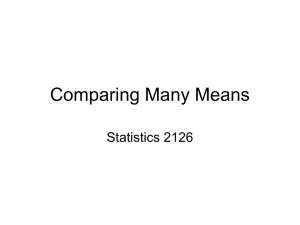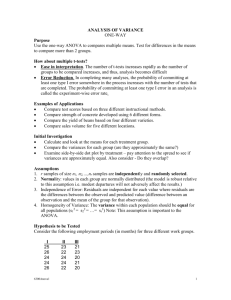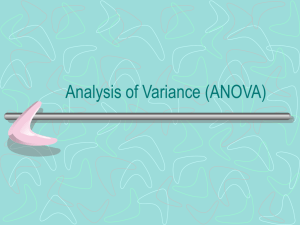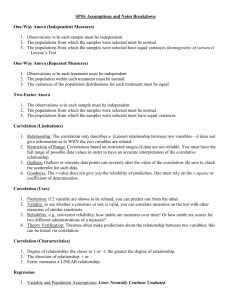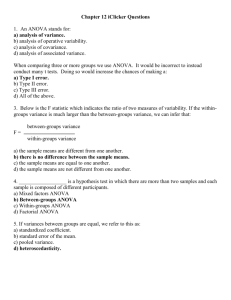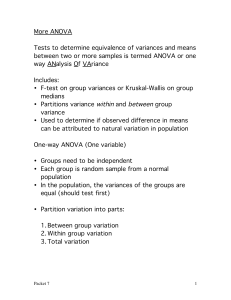ANOVA = Analysis Of Variance = HT for determining if there is any
advertisement
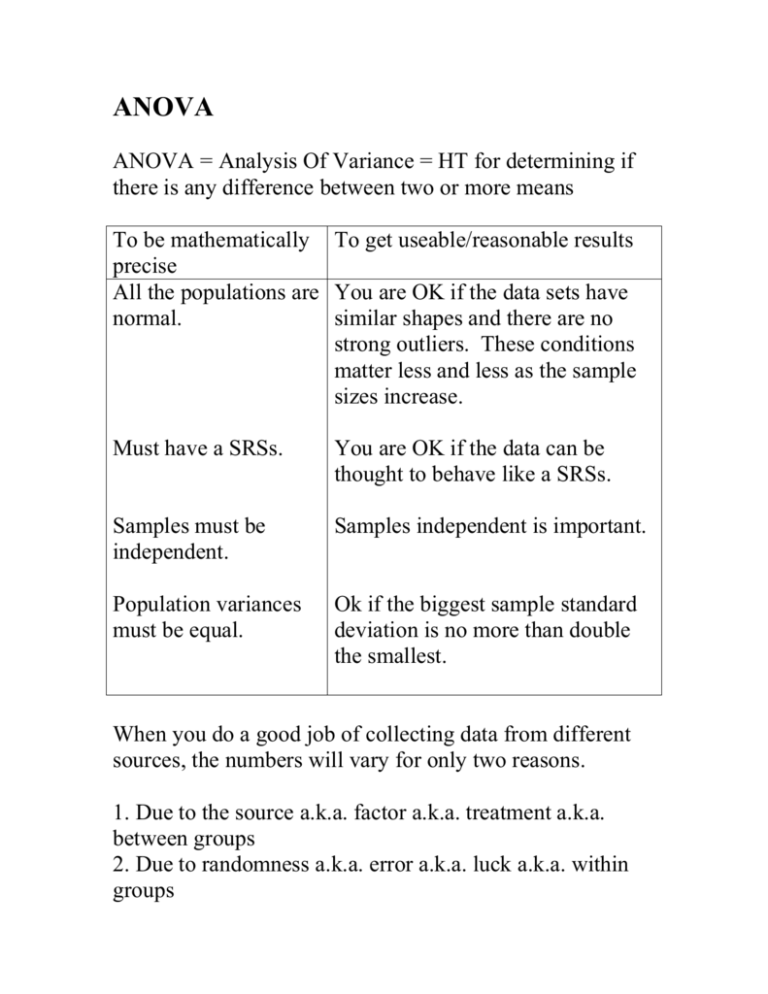
ANOVA ANOVA = Analysis Of Variance = HT for determining if there is any difference between two or more means To be mathematically To get useable/reasonable results precise All the populations are You are OK if the data sets have normal. similar shapes and there are no strong outliers. These conditions matter less and less as the sample sizes increase. Must have a SRSs. You are OK if the data can be thought to behave like a SRSs. Samples must be independent. Samples independent is important. Population variances must be equal. Ok if the biggest sample standard deviation is no more than double the smallest. When you do a good job of collecting data from different sources, the numbers will vary for only two reasons. 1. Due to the source a.k.a. factor a.k.a. treatment a.k.a. between groups 2. Due to randomness a.k.a. error a.k.a. luck a.k.a. within groups ANOVA checks to see if the variance due to the factor is large relative to the variance due to error, if so then Ho: all means are equal can be rejected in favor of Ha: there is some difference. The rejection region is always to the right since we use Fdata variance due to factor / variance due to error, and this will be big (to the right) when data vary a lot due to factor as compared to error. Note: There is a t/z version of ANOVA on line 4 in our formula table, but it only works for 2 populations and we won’t use it. The word “weighted” appears below. By weighted we mean that if there is more data from a source it is counted more. s 2factor is called variance due to factor and it is a weighted measure of the variability of the sample means. _ s 2factor _ ni ( xi x) 2 df factor where the sum is over each of the S i x df S 1 sources and factor and n _ _ _ n xi . x is the mean of all the data. ni is how many pieces of data from source i. 2 serror is called variance due to error and it is a weighted average of the variability within each source. s 2 error (n i 1) si2 df error where the sum is over each of the S sources and dferror ni S To have the best evidence for any difference in means from 2 2 different sources we want s factor to be big and serror to be small. Example: Suppose four guys go shoot 10 free-throws everyday at lunch and they record how many they make. Not everyone makes it everyday, so we may not have the same number of scores for each guy. We could calculate the sample means and standard deviations for each guy. The data might look like: Beavis Homer Moe Apu 9 4 7 10 8 4 7 8 6 9 6 3 _ _ _ _ xB xH xM x A sB2 sH2 sM2 s A2 To have good evidence of any difference in their mean scores how do we want the sample means to behave? 2 Measuring how theses sample means vary is what s factor does. To have good evidence of any difference in means how do we want the sample variances to behave? 2 serror measures on average how big (or small) these sample variances are. Note that when finding the critical value from the F table the df factor are along the top and the df error are on the left. Example: Which situation gives clearer evidence that there is a difference in the source means? Which situation has the numbers vary more due to source than randomness? In each case Source 1 data are the hearts, Source 2 data are the smiley faces, and Source 3 data are the triangles. Situation #1 Data from Source 1 8 7 4 1 Data from Source 2 2 9 8 5 Data from Source 3 10 3 6 9 Situation #2 Data from Source 1 5.2 5.1 4.9 4.8 Data from Source 2 6.2 5.8 5.9 6.1 Data from Source 3 7.1 6.9 7.2 7.8 Note that in each case the means are 5, 6, and 7 respectively and the variance due to factor is the same. But in case #2, the data vary almost entirely due to factor, while in case #1, the data vary a fair amount due to randomness. Because of this we have better evidence in case #2 and sure enough in case #2 the variance due to error is small compared to the variance due to the factor, at least as when s 2factor compared to case #1. Case #2 will have Fdata s 2 error larger than case #1. A comparison of ANOVA is a TV signal in the old days of analog and a screen of “snow” or “noise”. In ANOVA we want good evidence of a difference. To get this we want the sample means to vary a lot, and we want the data to be consistent from each source. For the TV signal we want the information of the TV show there (like a difference in sample means), but we don’t want lots of interference or noise (like data that is inconsistent from each source). It should be noted that there are techniques to do these procedures that may seem very different but are mathematically equivalent to the procedures here.
